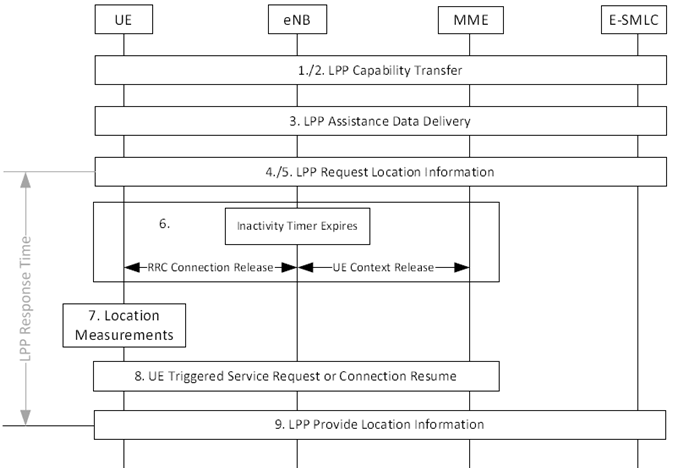Content for TS 36.305 Word version: 18.0.0
7.1.3 UE positioning measurements in idle state for NB-IoT p. 34
NB-IoT UEs may perform measurements for some positioning methods only when in idle state.
Figure 7.1.3-1 shows the general positioning procedure where the UE performs positioning measurements in idle state.

Step 1.
The E-SMLC is aware of the UE access type and/or coverage level if applicable from the Location Service Request message received from the MME. The E-SMLC may send a LPP Request Capabilities message to the UE to obtain the UE positioning method capabilities from the UE, as described in clause 7.1.2.1.
Step 2.
The UE sends its positioning method capabilities to the E-SMLC in a LPP Provide Capabilities message, including an indication of position methods for which the UE needs to make measurements in idle state.
Step 3.
The E-SMLC may determine the assistance data required for the selected position method or methods, and sends them in one or more LPP Provide Assistance data messages to the UE, as described in clause 7.1.2.2. If an LPP acknowledgement was requested, the UE sends an LPP acknowledgment for each received LPP Provide Assistance data message to the E-SMLC.
Step 4.
If the UE capabilities from step 2 indicate that idle state is required for positioning measurements, the E-SMLC may allow additional response time to the UE to obtain the location measurements, and sends one or more LPP Request Location Information messages to the UE requesting positioning measurements or a location estimate, and including the required response time, as described in clause 7.1.2.3. For E-CID positioning method, when NRSRP/NRSRQ measurements are requested the UE is requested to provide NRSRP/NRSRQ measurements for intra-frequency neighbour cells and for inter-frequency neighbour cells. The UE may use inter-frequency information in system information of the serving cell specified in TS 36.331 to decide on which inter-frequency cells to measure.
Step 5.
The UE sends an LPP acknowledgement for each received LPP Request Location Information message to the E SMLC, if an LPP acknowledgement was requested at step 4 but does not perform the requested measurements.
Step 6.
The UE may finish any other activities in progress (e.g., SMS or data transfer), and waits until the network releases or suspends the connection (after a certain period of inactivity). The UE will then receive an RRC connection release or suspend from the eNodeB due to the expiration of the inactivity timer.
Step 7.
When the UE has entered idle state, the UE performs the measurements requested in step 4.
Step 8.
Before the location measurements are to be sent to the E-SMLC, the UE instigates a UE triggered service request or, when User Plane CIoT EPS optimization applies, the Connection Resume procedure as defined in TS 23.401, if the UE is not using Control Plane CIoT EPS Optimisation, in order to establish a signalling connection with the MME. If the UE is using Control Plane CIoT EPS Optimisation, procedures for Mobile Originated Data Transport in Control Plane CIoT EPS optimisation as defined in TS 23.401 are performed by the UE to establish a signalling connection with the MME.
Step 9.
When the LPP response time received in step 4 expires (or when location measurements are available before expiry), the UE sends one or more LPP Provide Location Information messages containing the requested location measurements or location estimate obtained in step 7 to the E-SMLC.